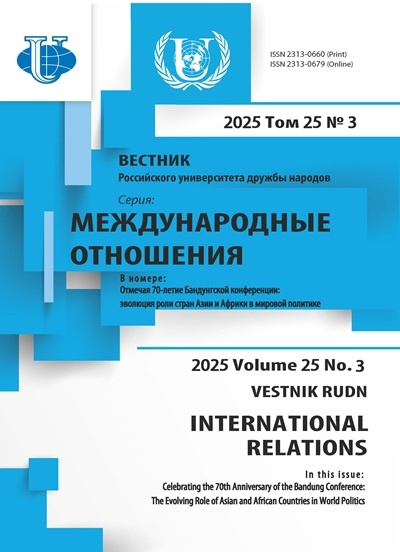РОЛЬ КИТАЙСКОЙ ДИАСПОРЫ В ФОРМИРОВАНИИ НОВОЙ ИММИГРАЦИОННОЙ ПОЛИТИКИ АВСТРАЛИИ
- Авторы: Каткова Е.Ю.1
-
Учреждения:
- Российский университет дружбы народов
- Выпуск: Том 18, № 3 (2018): Перспективы сотрудничества Юг—Юг. К 40-летию Буэнос-Айресского плана действий
- Страницы: 642-655
- Раздел: МИР И БЕЗОПАСНОСТЬ
- URL: https://journals.rudn.ru/international-relations/article/view/20109
- DOI: https://doi.org/10.22363/2313-0660-2018-18-3-642-655
- ID: 20109
Цитировать
Полный текст
Аннотация
Статья содержит исторический обзор миграционной политики Австралии, а также анализ роли китайской диаспоры в создании австралийского мультикультурного общества. Актуальность исследования определятся повышением значения дискуссии о правах человека и расовой дискриминации в политике развитых стран в связи с усилением процессов миграции в мире. В Австралии эта проблема не является новой, на протяжении большей части ХХ в. в стране действовала печально известная политика «Белой Австралии», которая ограничивала въезд для некоторых групп мигрантов, особенно из азиатских стран, с целью создания англо-кельтской австралийской нации, а также подразумевала дискриминационные меры для «нежелательных» этнических групп внутри страны. Однако послевоенная массовая миграция оказала значительное влияние на этнический состав населения, что, в свою очередь, оказало давление на правительство в признании культурного разнообразия и привело в начале 1970-х гг. к созданию концепции мультикультурного общества. Цель работы - проследить эволюцию общественного мнения в отношении китайских мигрантов и оценить роль китайской диаспоры в формировании новой иммиграционной политики Австралии. Помимо этого автор также исследует проблемы интеграции, расовой дискриминации и остаточного расизма в австралийском обществе на современном этапе. В заключение автор делает вывод о том, что, несмотря на некоторые проблемы мигрантов в области социальной интеграции, в настоящее время в австралийском обществе гармонично уживаются выходцы со всего света. Китайская диаспора является самой большой азиатской этнической группой в Австралии и выступает одним из факторов, влияющих на политические и экономические процессы в стране.
Об авторах
Евгения Юрьевна Каткова
Российский университет дружбы народов
Автор, ответственный за переписку.
Email: yeniya.dorogova@gmail.com
аспирант кафедры теории и истории международных отношений Российского университета дружбы народов
Список литературы
- Андерсон Б. Воображаемые сообщества. Размышления об истоках и распространении национализма. М.: КАНОН-пресс-Ц, Кучково поле, 2001
- Кон Х. Идея национализма // Мифы и заблуждения в изучении империи и национализма. М.: Новое издательство, 2010. C. 27-62
- Booth A., Leigh A., Varganova E. Does Ethnic Discrimination Vary Across Minority Groups? // Evidence from a Field Experiment. Oxford Bulletin of Economics and Statistics. 2012. Vol. 47. P. 547-573. DOI: https://doi.org/10.1111/j.1468-0084.2011.00664.x.
- Brawley S. The White Peril: Foreign Relations and Asian Immigration to Australasia and North America, 1919-1978. Sydney: UNSW Press, 1995.
- Collins J. Chinese entrepreneurs: The Chinese Diaspora in Australia // International Journal of Entrepreneurial Behavior & Research. 2002. Vol. 8. Iss. 1/2. P. 113-133. DOI: https://doi.org/ 10.1108/13552550210423750.
- Dutton D. One of Us?: A Century of Australian Citizenship. Sydney: UNSW Press, 2002.
- Fitzgerald J. Big White Lie: Chinese Australians in White Australia. Kensington: UNSW Press, 2007.
- Gao J. Chinese Migrant Entrepreneurship in Australia from the 1990s: Case Studies of Success in Sino-Australian Relations. Waltham, MA: Elsevier, 2015.
- Guo X. Immigrating to and ageing in Australia: Chinese experiences. PhD thesis. Murdoch University, 2005. URL: http://researchrepository.murdoch.edu.au/id/eprint/89/4/02Whole.pdf (accessed 12.06.2017).
- Henry N. A Multicultural Australia // The Australian Collaboration. 2013. URL: http://www.australiancollaboration.com.au/pdf/FactSheets/Multicultural-Australia-FactSheet.pdf (accessed 11.06.2017).
- Higgins C. Asylum by Boat: Origins of Australia's Refugee Policy. Sydney: UNSW Press, 2018.
- Jakubowicz A. Chinese Walls: Australian Multiculturalism and the Necessity for Human Rights // Journal of Intercultural Studies. 2011. Vol. 32. P. 691-706. DOI: https://doi.org/10.1080/ 07256868.2011.618111.
- Jones P. Chinese-Australian Journeys Records on Travel: Migration and Settlement, 1860-1975 // National Archives of Australia. 2005. URL: http://guides.naa.gov.au/chinese-australian-journeys/ (accessed 11.06.2017).
- Jupp J. From White Australia to Woomera: The Story of Australian Immigration. Cambridge: Cambridge University Press, 2002.
- Koleth E. Multiculturalism: a review of Australian policy statements and recent debates in Australia and overseas. Canberra: Department of Parliamentary Services, Parliamentary Library, 2010.
- LeFort C. White Australian Policy. Union: MelatiaeTrade Publishing, 2014.
- Liu X. Australia’s Chinese and Indian Business Diasporas: Demographic Characteristics and Engagement in Business, Trade and Investment. Melbourne: ACOLA, 2016.
- Mence V., Gangell S., Tebb R. A History of the Department of Immigration: Managing Migration to Australia. Canberra: Department of Immigration and Border Protection, 2015.
- Ngan L. L.-S., Kwok-bun C. The Chinese Face in Australia: Multi-generational Ethnicity among Australian-born Chinese. New York: Springer, 2012.
- York B. Australia and Refugees, 1901-2002: Annotated Chronology Based on Official Sources. Department of the Parliamentary Library. 2003. URL: http://www.aph.gov.au/binaries/ library/pubs/online/03chr02.pdf (accessed 11.06.2017).
Дополнительные файлы










